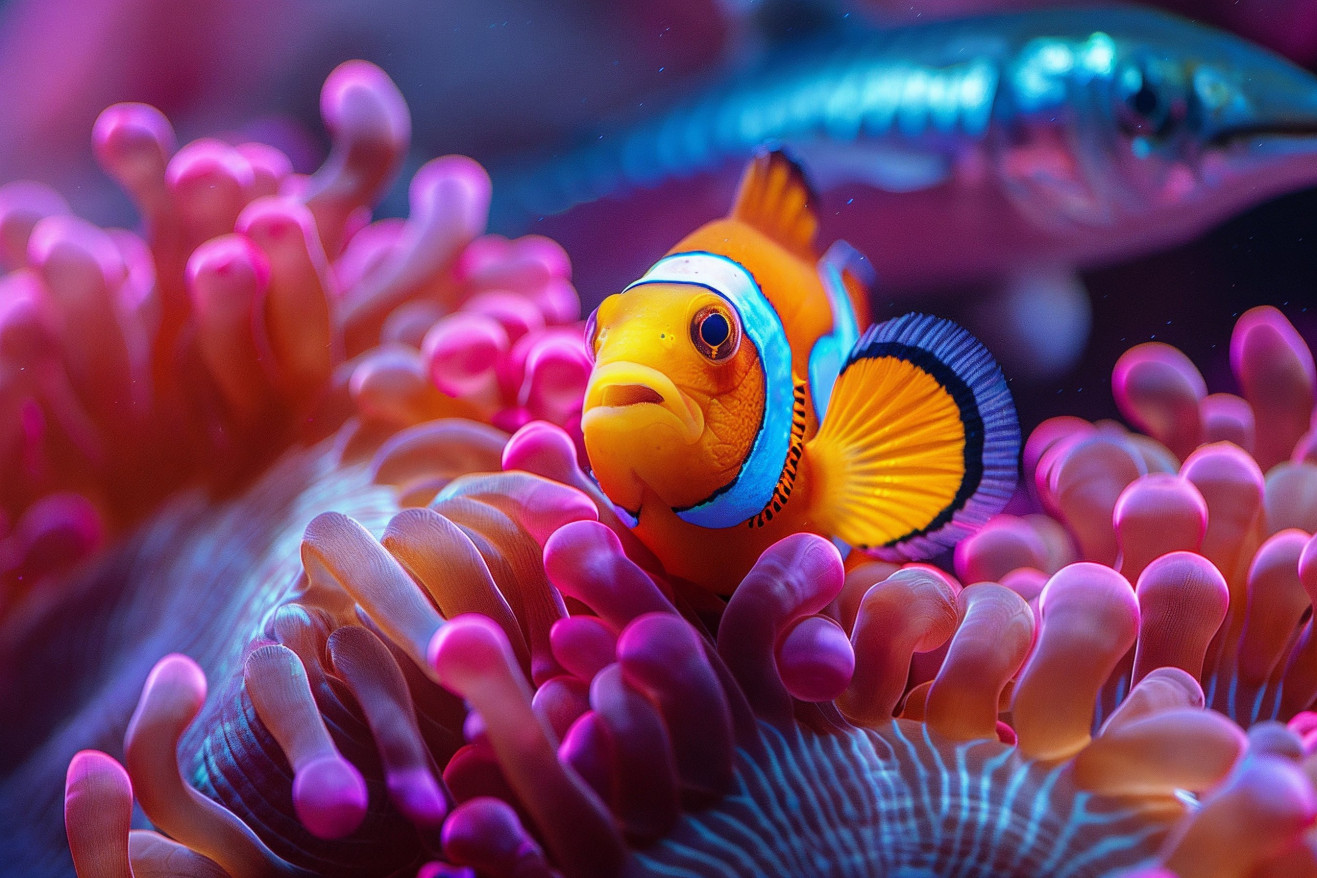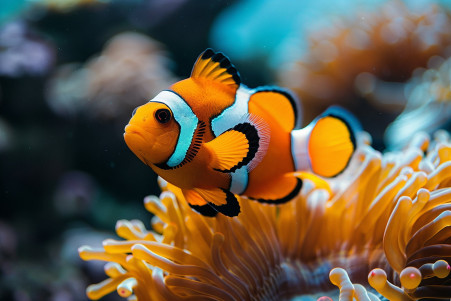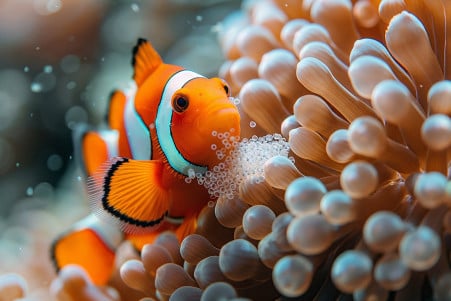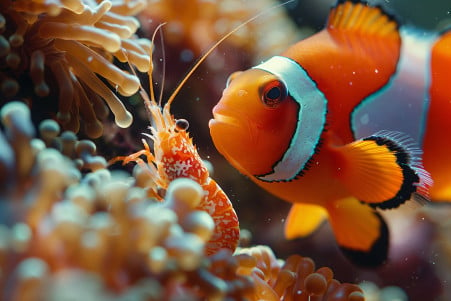Do Barracudas Eat Clownfish? Exploring Reef Predator-Prey Interactions
18 February 2024 • Updated 18 February 2024

Given that barracudas are a common predator on the reef, how do the brightly colored clownfish fare? While barracudas are capable of eating clownfish, they are not a typical prey for barracudas because of the symbiotic relationship between clownfish and sea anemones, which deters many predators. Clownfish are protected by the venomous tentacles of sea anemones, which makes the anemone a relatively safe place for clownfish from barracuda predation.
This article will explore the complex relationships in coral reef ecosystems that determine predator-prey interactions. Drawing on studies of marine biology, ecosystems, and animal behavior, we will build a picture of how barracudas hunt and what factors determine their prey choices, including the special adaptations of clownfish that help them survive. In doing so, we will investigate the complex web of life in the ocean to determine the probable interactions between barracudas and clownfish.
Do barracudas eat clownfish?
Barracudas Are Predators With a Varied Diet
Barracudas are known to be top predators in tropical and subtropical waters, and they are often found patrolling the edges of coral reefs, where they can use their speed and stealth to surprise their prey.
As a result, barracudas are solitary predators that are most active at night. Their body shape, speed, and sharp teeth enable them to use both the “sit-and-wait” and pursuit modes of predation, according to Animal Diversity Web.
In fact, scientists from the Field Museum of Natural History and the University of Chicago have shown that barracudas use their speed to ram feed, which involves hitting prey at high speed and then biting them, often in a single motion. This method is especially effective against a variety of fish.
Barracudas’ diet includes a wide range of fish, including tunas, mullets, jacks, and groupers, and they primarily rely on their vision to find their prey, says ThoughtCo.
While clownfish aren’t usually mentioned as part of the barracuda’s diet, it’s possible that a barracuda could eat a clownfish if it left the protection of its anemone. However, the barracuda’s hunting style and diet make it unlikely that it would seek out a clownfish, which supports the idea that the clownfish’s defenses are an important deterrent to predators like the barracuda.
Clownfish Symbiosis and Defense Mechanisms
Clownfish have a number of defense mechanisms, but their symbiotic relationship with sea anemones is by far the most well-known.
The fish are able to live among the anemone’s venomous tentacles because they secrete a mucus that prevents the stinging cells, or nematocysts, from injecting their toxins.
In return, the anemone gets food scraps from the clownfish, as well as protection from predators, including the barracuda, which is more likely to eat other fish. The Great Barrier Reef Foundation explains that clownfish and anemones are a classic example of mutualism, in which two species provide food and protection for one another.
Studies cited by Reef Craze suggest that the bright colors and patterns of clownfish may also be a form of warning coloration, or aposematism, that helps them avoid predators.
Their small size also makes them less attractive to predators, who are more likely to go after larger prey.
If they are threatened, clownfish can quickly dart into crevices or the tentacles of their anemone hosts. They also have a number of other defense mechanisms, including their territorial behavior and their ability to “play dead.” All of these factors have contributed to the clownfish’s evolutionary success, helping them survive in the busy, competitive world of the coral reef.
Coral Reef Ecosystems
Coral reef ecosystems, often referred to as the rainforests of the sea, are among the most diverse and multifaceted marine ecosystems on Earth. The species that constitute these ecosystems are all interconnected, resulting in a detailed and elaborate food web.
This is where the clownfish and the barracuda come in. The clownfish and the barracuda are two of the many species that make up the coral reef ecosystem, and their roles in the ecosystem are very different.
Clownfish live in the protective tentacles of sea anemones and feed on algae, small invertebrates, and zooplankton. Barracudas, on the other hand, are top predators in the coral reef ecosystem and help to control the populations of mid-level predators and other fish.
A paper in PNAS shows that coral reefs are highly sensitive to environmental changes, such as global warming and coral bleaching, and that these changes can lead to a dramatic loss of coral cover.
This loss of coral cover can lead to a loss of structural complexity, which is important for maintaining biodiversity.
A loss of complexity has a significant impact on the fish that live in the coral reef, leading to a loss of species and changes in the trophic structure of the ecosystem.
The health of the coral reef and the complex interactions between species that it supports are important for the survival of both the clownfish and the barracuda. As the environment changes and the complexity of the habitat changes, the balance between predators and prey in the ecosystem will change.
The ability of the clownfish to survive in this changing environment will depend on its ability to find and adapt to the changes in the reef.
The Complex Symbiotic and Survival Strategies of Clownfish
In addition to their symbiotic relationships, clownfish have developed highly specialized sensory and behavioral adaptations to avoid predators, which is essential for their survival in the predator-filled coral reef environments.
Their mutualistic relationship with sea anemones is a key part of their overall defense strategy. A study in BMC Ecology and Evolution has shown that clownfish have evolved behaviors and physical characteristics that allow them to live with toxic sea anemones and have adapted their relationships with these creatures to help them avoid predators like barracudas.
In addition to their symbiotic relationships, clownfish have also developed highly specialized sensory systems. For example, ScienceDaily reported on a study that found that juvenile clownfish use their sense of hearing to detect and escape from predators. However, the same study also found that the increased CO2 levels that lead to ocean acidification could impact this important adaptation, potentially making clownfish deaf to the sounds of predators and more vulnerable to predation by barracudas.
In the past, these sensory and behavioral adaptations have helped clownfish successfully navigate their ecological niche. However, the threat of climate change and other environmental factors is creating new obstacles that could impact the effectiveness of these survival strategies and, in turn, the balance between clownfish and their predators.
What This Tells Us About How Barracudas Hunt
Barracudas’ exceptional vision is one of the key ways that they are able to be such successful predators. According to BioExpedition, these torpedo-shaped predators are unique among fish in that they rely almost exclusively on their vision to hunt. Their vision is so good that they are able to see their prey from a distance, enabling them to plan and execute an attack.
While the study doesn’t go into detail about barracudas’ sense of smell, their sensory biology clearly plays a role in their ability to hunt.
Barracudas are opportunistic predators, and their vision is a key part of their hunting strategy because they are attracted to shiny objects that look like the flash of fish scales. This could also be true of the flash of clownfish as they dart in and out of their anemone homes, according to Lamar University.
The role of vision and other senses in the barracuda’s hunting strategy is clearly complex. More research would be needed to understand exactly how these senses help barracudas find their way in their coral reef habitats and identify potential prey like clownfish. However, it’s clear that their sensory abilities not only help them hunt but also help them assess and often avoid the well-protected clownfish in favor of other prey.
Unraveling the Marine Mystery: What Happens to Clownfish in Barracuda Territory
In the complex web of coral reef ecosystems, predator-prey interactions are multi-faceted and ever-changing. Our investigation has shown that while barracudas are highly skilled predators with a range of senses that help them hunt, they are unlikely to prey on clownfish due to the clownfish’s successful symbiotic defenses. The clownfish’s partnership with poisonous sea anemones is a key to its survival, providing a safe haven that is nearly impenetrable to barracuda predation.
This mutualism, which is part of the larger web of life on the coral reef, shows the importance of the relationships that keep these underwater environments going. When these relationships are disrupted, whether by climate change or other human-induced factors, it can have a domino effect on the reef, which is why it’s so important to protect them.
Marine biologists are helping to do this by studying the relationships between species and helping to inform conservation efforts.
In the end, the chances of a barracuda preying on a clownfish are slim, proving that evolution and natural selection are powerful forces. On the reef, each species has its place, and for the clownfish, its bright colors and its partnership with the anemone have given it the tools it needs to defend against the fast-moving barracuda.


